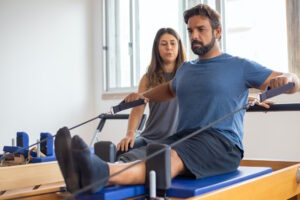
Welcome to the world of Pilates for Rehabilitation! In this comprehensive guide, we will explore the use of Pilates in rehabilitation, its introduction, and the core concepts that underpin this effective form of exercise. Whether you’re a seasoned Pilates enthusiast or completely new to the practice, we aim to provide you with a clear and accessible understanding of how Pilates can play a vital role in the rehabilitation process.
What is the use of Pilates in rehabilitation?
Pilates is a versatile and effective method that has gained popularity in various rehabilitation settings. It is widely recognized for its ability to address a wide range of physical issues and aid in the recovery process. Some key benefits of incorporating Pilates into rehabilitation include:
1. Core Strength and Stability: Pilates places a strong emphasis on building core strength, which helps stabilize the spine and improve overall body alignment. This aspect is particularly beneficial for individuals recovering from back injuries, post-surgery, or experiencing chronic pain.
2. Flexibility and Range of Motion: The controlled and fluid movements in Pilates promote flexibility, helping to restore and improve range of motion in joints affected by injury or surgery. This aspect is crucial in preventing stiffness and promoting functional movement.
3. Muscle Imbalance Correction: Injuries often result in muscle imbalances, where some muscles become weaker while others compensate and become overly tight. Pilates exercises target specific muscle groups to correct these imbalances, leading to better overall body mechanics.
4. Low Impact and Safe: Pilates is a low-impact exercise method, making it suitable for various individuals, including those with joint issues, elderly populations, or individuals with limited mobility. It provides a gentle yet effective way to engage the body without putting undue stress on joints.
5. Mind-Body Connection: Pilates promotes mindfulness and body awareness, encouraging participants to connect with their bodies on a deeper level. This heightened awareness helps in identifying and correcting movement patterns that may contribute to injuries.
What is the introduction of Pilates?
Pilates was developed by Joseph H. Pilates in the early 20th century. Born in Germany, he was a fitness enthusiast who explored various exercise forms. During World War I, he worked as a nurse, using his knowledge of body movement and exercise to rehabilitate injured soldiers. This experience laid the foundation for the principles of Pilates as we know them today.
Joseph Pilates initially called his method “Contrology,” highlighting the emphasis on controlled movements. The practice combines elements of yoga, martial arts, gymnastics, and Western forms of exercise. In the 1920s, Pilates immigrated to the United States, where he opened a studio in New York City. Over time, his method gained popularity, especially among dancers and athletes, for its effectiveness in improving strength, flexibility, and overall physical well-being.
What is the concept of Pilates?
The Pilates method is based on several core concepts that set it apart from traditional exercise routines:
1. Breathing: Pilates emphasizes a specific breathing pattern, where participants breathe deeply into their ribcages, engaging the diaphragm and promoting better oxygenation. This controlled breathing not only enhances concentration but also supports the engagement of core muscles.
2. Centering: Often referred to as the powerhouse, Pilates focuses on strengthening the core muscles, including the abdomen, lower back, hips, and glutes. A strong center provides a stable foundation for movement and protects the spine.
3. Control: As the name “Contrology” suggests, Pilates is all about control. Each movement is performed with precision and mindfulness, ensuring that no body part is neglected or overworked.
4. Concentration: Pilates requires full concentration during exercises, encouraging participants to be present in the moment and fully engaged with their bodies. This heightened awareness improves the quality and effectiveness of each movement.
5. Precision: Every Pilates exercise has a specific alignment and form. Practitioners are encouraged to perform movements with precision, avoiding haphazard motions that can lead to injuries.
6. Flow: Pilates exercises are designed to flow smoothly from one to another, creating a sense of continuity and rhythm throughout the practice. This flowing nature helps in promoting grace, balance, and coordination.
Summary
In conclusion, Pilates for Rehabilitation is a powerful and versatile method that offers numerous benefits for individuals seeking to recover from injuries, surgeries, or physical limitations. Its emphasis on core strength, flexibility, muscle balance, and mindful movement makes it an ideal complement to the rehabilitation process. Pilates, originally known as Contrology, was developed by Joseph H. Pilates and has evolved over the years to become a popular form of exercise worldwide. Its core concepts of breathing, centering, control, concentration, precision, and flow create a unique and effective approach to physical wellness and rehabilitation. By integrating Pilates into rehabilitation programs, individuals can experience improved physical function, enhanced body awareness, and a greater sense of overall well-being.